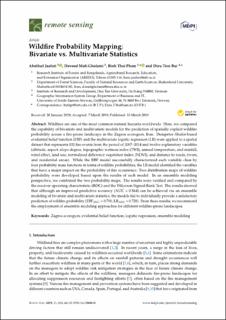| dc.description.abstract | Wildfires are one of the most common natural hazards worldwide. Here, we compared the capability of bivariate and multivariate models for the prediction of spatially explicit wildfire probability across a fire-prone landscape in the Zagros ecoregion, Iran. Dempster–Shafer-based evidential belief function (EBF) and the multivariate logistic regression (LR) were applied to a spatial dataset that represents 132 fire events from the period of 2007–2014 and twelve explanatory variables (altitude, aspect, slope degree, topographic wetness index (TWI), annual temperature, and rainfall, wind effect, land use, normalized difference vegetation index (NDVI), and distance to roads, rivers, and residential areas). While the EBF model successfully characterized each variable class by four probability mass functions in terms of wildfire probabilities, the LR model identified the variables that have a major impact on the probability of fire occurrence. Two distribution maps of wildfire probability were developed based upon the results of each model. In an ensemble modeling perspective, we combined the two probability maps. The results were verified and compared by the receiver operating characteristic (ROC) and the Wilcoxon Signed-Rank Test. The results showed that although an improved predictive accuracy (AUC = 0.864) can be achieved via an ensemble modeling of bivariate and multivariate statistics, the models fail to individually provide a satisfactory prediction of wildfire probability (EBFAUC = 0.701; LRAUC = 0.728). From these results, we recommend the employment of ensemble modeling approaches for different wildfire-prone landscapes. | en_US |

